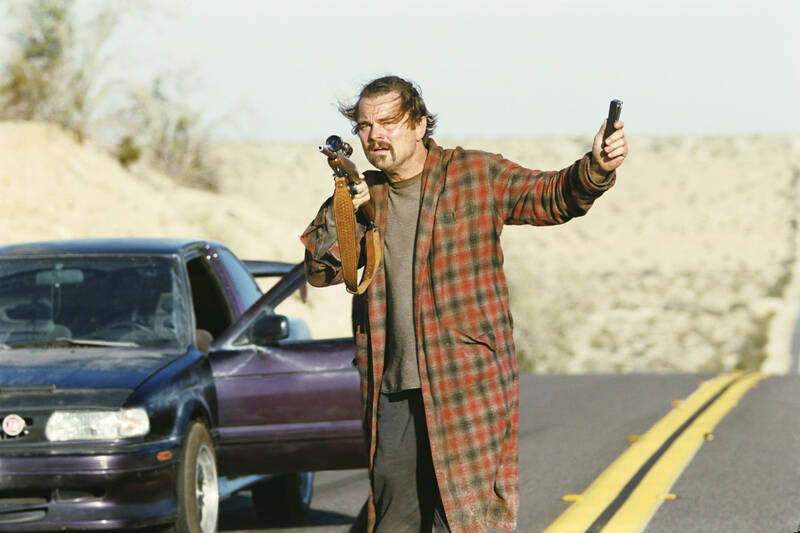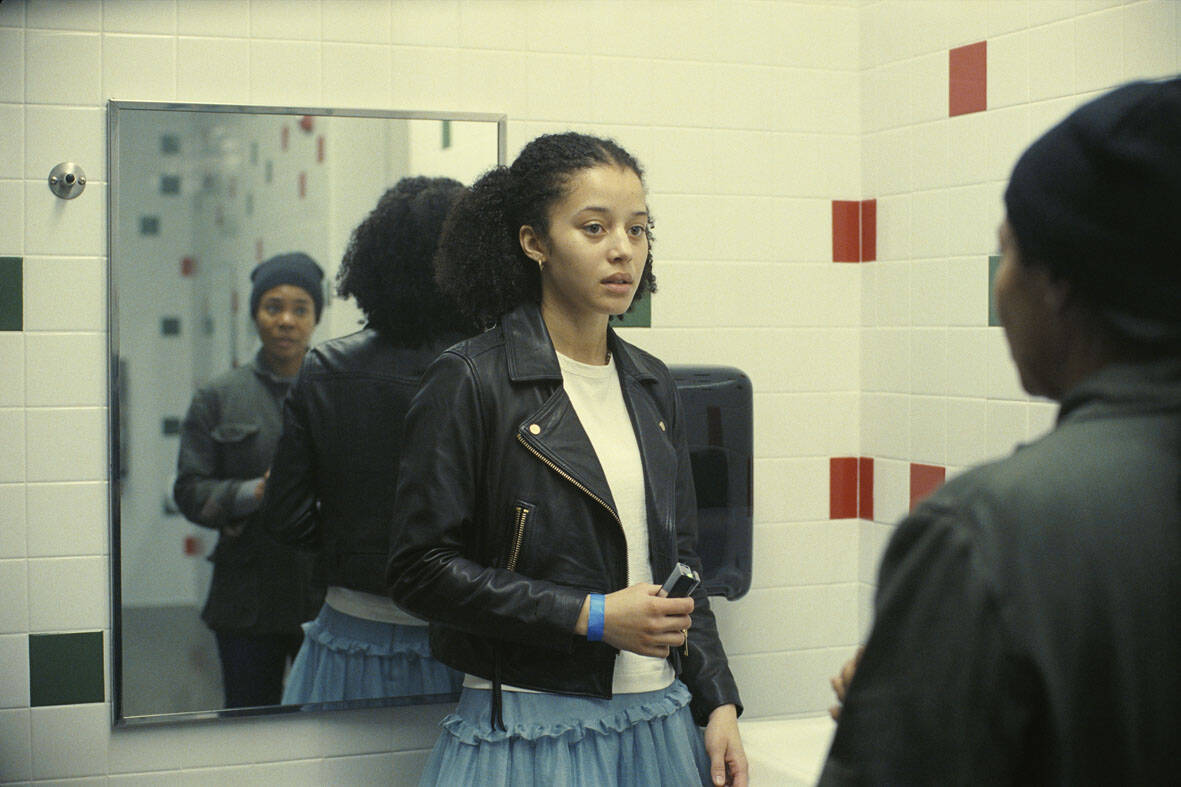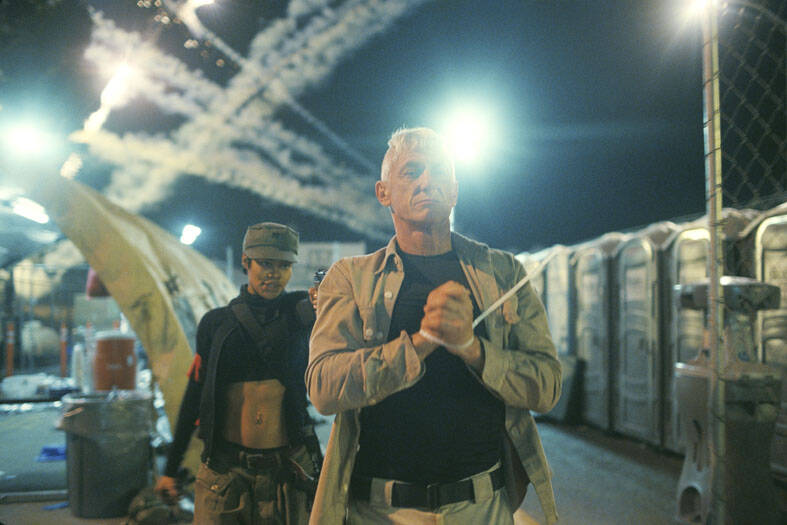In Paul Thomas Anderson ’s gloriously messy, madcap roller coaster ride through modern America, objects in the rear view may go out of sight, but they don’t disappear.
Political struggles never die in One Battle After Another, they just repeat. Or maybe they grow older and become paranoid, pot-smoking, pajama-wearers like Bob Ferguson ( Leonardo DiCaprio ), a washed-up revolutionary living off the grid with his daughter, Willa (Chase Infiniti). The cycles of oppression and resistance are palpably felt in Anderson’s film, a decades-spanning odyssey where gun violence, white power and immigrant deportations recur in an ongoing dance, both farcical and tragic.
But One Battle After Another could also be fairly described as a sweet movie about a father coming to terms with his teenage daughter having a phone — which is one example of how Anderson’s destabilizing approach to big themes can turn poignant and revelatory. “Sweeping” would normally be a way to characterize a nearly three-hour-long, multigeneration saga like this, but Anderson works in a more rough-hewn, compassionate register that burrows strangely but acutely into the American psyche.

Photo: AP
One Battle After Another is arriving after months of speculation and some skepticism because it’s easily Anderson’s biggest budgeted, largest scaled film yet. But scale is an interesting thing when it comes to Anderson’s movies. Magnolia is modest by most metrics, but you’d be hard pressed to find a more ambitious movie. There Will Be Blood didn’t feature much spectacle beyond some rickety wooden oil rigs, but it feels about as large as the frame of Daniel Day-Lewis’ Daniel Plainview, which is to say terrifyingly enormous.
Likewise, One Battle After Another, shot on VistaVision, is big and long but feels intimate and fast. That’s partly due to the propulsion of its opening prologue and the absurd knockout vigor of Teyana Taylor as a scorching, potent screen presence. Her Perfidia Beverly Hills is at the center of the movie’s beginning. And she makes such a powerful mark that it takes half an hour for One Battle After Another to pick up the pieces after it moves on. (My personal recovery time is ongoing.)
We first see Perfidia, dressed in all black, striding across an overpass. Below is an immigration detention center. The atmosphere is tumultuous. Bob is there, ready to set off fireworks or bombs, but has little clue of the plan. She assures him: “Make it big, make it bright. Inspire me.”

Photo: AP
They and their co-conspirators soon announce their intentions, freeing the immigrants, tying up the military guards and declaring that they’re the radical group the French 75. This is the start, Perfidia says, of a revolution. Their cause is righteous but their drive is visceral and sexual. Bomb-making and sex go hand in hand. Bob trails after Perfidia, in love with her but also in awe. Perfidia’s mother doesn’t give them much of a chance as a couple. “She’s a runner and you’re a stone,” she tells him.
At the same time, Perfidia comes in contact with Colonel Lockjaw (Sean Penn), a rock-jawed military man who, too, swoons for Perfidia. When they first meet, she holds him at gunpoint and tells him to “Get it up,” and she doesn’t mean his hands. These charged scenes, followed by Perfidia’s pregnancy and new police trouble for the French 75, set the table for the drama to come, set 16 years after this opening salvo, a frenetic eruption of Black and female power.
By then, the forces fought by the radicals have clawed back their advantage. Lockjaw (this is a taut, drained, maniacal Penn) now moves with impunity, directing troops on illegal raids where he chooses. Some of those in power like what he’s doing. A secret white supremacist group called the Christmas Adventurers (they speak of cleansing the Earth and greet each other with “merry Christmas”) offers him a membership.

Photo: AP
The French 75 are essentially no more. Bob is now alone with their 16-year-old daughter. He’s grown less connected with the world. He calls his daughter’s friend “Homie,” has trouble with pronouns and usually has a roach going. It’s the most Lebowski-esque performance by DiCaprio, whose recent gravity toward less polished, error-prone characters (Killers of the Flower Moon, Once Upon a Time in Hollywood) has made for some of his most interesting movies.
Willa, though, is said to have her mother’s courage. (Infiniti, a newcomer, has an inner strength that comes across clear as day.) When Lockjaw comes looking for Willa, a new cycle of state-sponsored violence is set off. That brings in a delightful Benicio Del Toro as a combination sensei and Harriet Tubman-like figure to immigrants who shepherds Bob when the authorities are closing in. This is probably the most shambolic section of the movie, but Del Toro’s Sergio St. Carlos is also the film’s most resonate encapsulation of freedom. He’s free because his purpose is clear and principled.
This is a movie filled with police convoys across the land and military tactics that effectively turn modern-day America into a battlefield. The film, inspired by Thomas Pynchon’s Vineland, shares some of the culture clash of Anderson’s earlier Pynchon adaptation, Inherent Vice. But One Battle After Another, graced with a swelling score by Johnny Greenwood that gives the movie a hint of epic, feels more urgently contemporary and more morally motivated.
That makes One Battle After Another, as a major studio release clattering with straightforward representations of racism, xenophobia and vigilantism, an exception in almost every way to modern-day Hollywood. I’m sure that will bring debate, just as any good movie does. And I’m sure some will find its American portrait muddled and chaotic. But those aspects feel true, too, just as does the movie’s abiding fighting spirit.

Every now and then, it’s nice to just point somewhere on a map and head out with no plan. In Taiwan, where convenience reigns, food options are plentiful and people are generally friendly and helpful, this type of trip is that much easier to pull off. One day last November, a spur-of-the-moment day hike in the hills of Chiayi County turned into a surprisingly memorable experience that impressed on me once again how fortunate we all are to call this island home. The scenery I walked through that day — a mix of forest and farms reaching up into the clouds

With one week left until election day, the drama is high in the race for the Chinese Nationalist Party (KMT) chair. The race is still potentially wide open between the three frontrunners. The most accurate poll is done by Apollo Survey & Research Co (艾普羅民調公司), which was conducted a week and a half ago with two-thirds of the respondents party members, who are the only ones eligible to vote. For details on the candidates, check the Oct. 4 edition of this column, “A look at the KMT chair candidates” on page 12. The popular frontrunner was 56-year-old Cheng Li-wun (鄭麗文)

“How China Threatens to Force Taiwan Into a Total Blackout” screamed a Wall Street Journal (WSJ) headline last week, yet another of the endless clickbait examples of the energy threat via blockade that doesn’t exist. Since the headline is recycled, I will recycle the rebuttal: once industrial power demand collapses (there’s a blockade so trade is gone, remember?) “a handful of shops and factories could run for months on coal and renewables, as Ko Yun-ling (柯昀伶) and Chao Chia-wei (趙家緯) pointed out in a piece at Taiwan Insight earlier this year.” Sadly, the existence of these facts will not stop the

Oct. 13 to Oct. 19 When ordered to resign from her teaching position in June 1928 due to her husband’s anti-colonial activities, Lin Shih-hao (林氏好) refused to back down. The next day, she still showed up at Tainan Second Preschool, where she was warned that she would be fired if she didn’t comply. Lin continued to ignore the orders and was eventually let go without severance — even losing her pay for that month. Rather than despairing, she found a non-government job and even joined her husband Lu Ping-ting’s (盧丙丁) non-violent resistance and labor rights movements. When the government’s 1931 crackdown